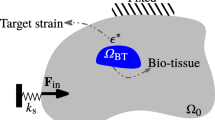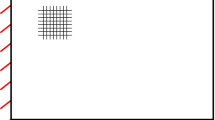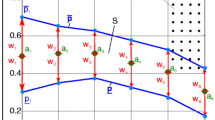Abstract
Piezoelectric actuators have received substantial attention among the industry and academia due to quick responses, such as high output force, high stiffness, high accuracy, and precision. However, the design of piezoelectric actuators always suffers from the emergence of several localized hinges with only one-node connection, which have difficulty satisfying manufacturing and machining requirements (from the over- or under-etching devices). The main purpose of the current paper is to propose a robust isogeometric topology optimization (RITO) method for the design of piezoelectric actuators, which can effectively remove the critical issue induced by one-node connected hinges and simultaneously maintain uniform manufacturability in the optimized topologies. In RITO, the isogeometric analysis replacing the conventional finite element method is applied to compute the unknown electro elastic fields in piezoelectric materials, which can improve numerical accuracy and then enhance iterative stability. The erode—dilate operator is introduced in topology representation to construct the eroded, intermediate, and dilated density distribution functions by non-uniform rational B-splines. Finally, the RITO formulation for the design of piezoelectric materials is developed, and several numerical examples are performed to test the effectiveness and efficiency of the proposed RITO method.
Similar content being viewed by others
Abbreviations
- CAMD:
-
Continuous approximation of material distribution
- DDF:
-
Density distribution function
- FEM:
-
Finite element method
- IGA:
-
Isogeometric analysis
- ITO:
-
Isogeometric topology optimization
- MEMS:
-
Micro-electro-mechanical system
- MMA:
-
Method of moving asymptotes
- NURBS:
-
Non-uniform rational B-splines
- OC:
-
Optimality criteria
- PEMAP:
-
Piezoelectric material with penalization
- PEMAP-P:
-
Piezoelectric material with penalization and polarization
- PZT:
-
Lead zirconate titanate
- RITO:
-
Robust isogeometric topology optimization
- SIMP:
-
Solid isotropic material penalization
- B u :
-
Strain—displacement matrix
- c E :
-
Stiffness tensor in constant electrical field
- D :
-
Electrical displacement
- e :
-
Number of the finite element
- e :
-
Piezoelectric coefficient matrix
- E :
-
Electrical field
- E 0, e 0, ε 0 :
-
Stiffness, electromechanical coupling, and dielectric coefficients of piezoelectric solids, respectively
- E mjn, e min, ε min :
-
Minimum values of stiffness, electromechanical coupling, and dielectric coefficients of the voids, respectively
- f :
-
Global force imposed at the design domain
- f b :
-
Body force
- fd:
-
Dummy load
- f e :
-
Force in the eth finite element
- f s :
-
Surface traction
- G 1 :
-
Volume constraint for the eroded, intermediate, and dilated topologies
- G 2 :
-
Volume constraint in the intermediate design
- G (Φ):
-
Volume constraint function
- h :
-
Thickness of the piezoelectric plate
- i :
-
Number of control point in the first parametric direction
- j :
-
Number of control point in the second parametric direction
- J :
-
Objective function
- J 1 :
-
Jacobi matrix from the parametric space to physical space
- J 2 :
-
Jacobi matrix from the bi-unit parent element space to parametric space
- k uu :
-
Spring stiffness at the output location
- k uu :
-
Mechanical stiffness matrix
- k uφ :
-
Piezoelectric coupling matrix
- k φφ :
-
Dielectric stiffness matrix
- m, n :
-
Total number of control points in the parametric directions η and ξ, respectively
- M j,q :
-
B-spline basis functions in the second parametric direction
- N i,p :
-
B-spline basis functions in the first parametric direction
- p :
-
Degree of NURBS basis functions in the first parametric direction
- p uu, p uφ, p φφ, p po :
-
Penalization parameters for stiffness, piezoelectricity, dielectric, and polarization, respectively
- q :
-
Degree of NURBS basis functions in the second parametric direction
- q c :
-
Surface charge density accumulated on the electrodes
- q e :
-
Charge density in the eth finite element
- \(R_{i,j}^{p,q}\) :
-
NURBS basis functions in 2D
- S :
-
Mechanical strain
- T :
-
Mechanical stress
- u :
-
Displacement field
- u e :
-
Displacement field in the eth finite element
- u i,j :
-
Displacement at the (i,j)th control point
- u out :
-
Output displacement at the specified locations of the design domain
- V max :
-
Maximum material consumption
- ω i,j :
-
Positive weight at the (i,j)th control point
- ξ, ζ :
-
First and second parametric directions, respectively
- ε S :
-
Permittivity coefficient matrix
- φ :
-
Electric potential
- φ e :
-
Electric potential in the eth finite element
- Ωe :
-
Physical design domain of the eth IGA element
- \(\widetilde\Omega \) :
-
Bi-unit parent element
- φ :
-
Control design variable
- φ min :
-
Positive integer to avoid the occurrence of numerical singularity
- \({{\hat \varphi }_{{\rm{eo}}}},{{\hat \varphi }_{{\rm{id}}}},{{\hat \varphi }_{{\rm{do}}}}\) :
-
Eroded, intermediate, and dilated control design variables, respectively
- \({{\tilde \varphi }_{i,j}}\) :
-
(i, j)th smoothed control design variable
- β, η :
-
First and second parameters in the threshold projection, respectively
- η eo, η id, η do :
-
Different values of the parameter η to define the erode, intermediate and dilate operators in threshold projection, respectively
- λ :
-
Adjoint vector of the dummy load
- Φ:
-
Density distribution function
- Φeo, Φid, Φdo :
-
Eroded, intermediate, and dilated DDFs, respectively Φiso Value of the iso-contour of the DDF
- Φtop :
-
Structural topology
- Φ eotop ,Φ idtop ,Φ dotop :
-
Eroded, intermediate, and dilated topologies, respectively
- ψ :
-
Second type of design variables for the polarization
- ψ:
-
Continuous function for the second type of design variable
- Ψeo, Ψid, Ψdo :
-
Eroded, intermediate, and dilated continuous functions for the second type of design variable, respectively
- Ψ eotop ,Ψ idtop ,Ψ dotop :
-
Optimized distributions of the polarization in three eroded, intermediate, and dilated designs, respectively
References
Frecker M I. Recent advances in optimization of smart structures and actuators. Journal of Intelligent Material Systems and Structures, 2003, 14(4–5): 207–216
Adriaens H J M T S, De Koning W L, Banning R. Modeling piezoelectric actuators. IEEE/ASME Transactions on Mechatronics, 2000, 5(4): 331–341
Zhang Y K, Tu Z, Lu T F, Al-Sarawi S. A simplified transfer matrix of multi-layer piezoelectric stack. Journal of Intelligent Material Systems and Structures, 2017, 28(5): 595–603
Pérez R, Agnus J, Clévy C, Hubert A, Chaillet N. Modeling, fabrication, and validation of a high-performance 2-DoF piezoactuator for micromanipulation. IEEE/ASME Transactions on Mechatronics, 2005, 10(2): 161–171
Bendsøe M P, Sigmund O. Topology Optimization: Theory, Methods and Applications. Berlin: Springer, 2003
Gao J, Luo Z, Li H, Gao L. Topology optimization for multiscale design of porous composites with multi-domain microstructures. Computer Methods in Applied Mechanics and Engineering, 2019, 344: 451–476
Liu H, Zong H M, Shi T L, Xia Q. M-VCUT level set method for optimizing cellular structures. Computer Methods in Applied Mechanics and Engineering, 2020, 367: 113154
Li Q H, Sigmund O, Jensen J S, Aage N. Reduced-order methods for dynamic problems in topology optimization: a comparative study. Computer Methods in Applied Mechanics and Engineering, 2021, 387: 114149
Chu S, Featherston C, Kim H A. Design of stiffened panels for stress and buckling via topology optimization. Structural and Multidisciplinary Optimization, 2021, 64(5): 3123–3146
Chu S, Townsend S, Featherston C, Kim H A. Simultaneous layout and topology optimization of curved stiffened panels. AIAA Journal, 2021, 59(7): 2768–2783
Silva E C N, Fonseca J S O, Kikuchi N. Optimal design of piezoelectric microstructures. Computational Mechanics, 1997, 19(5): 397–410
Silva E C N, Fonseca J S O, de Espinosa F M, Crumm A T, Brady G A, Halloran J W, Kikuchi N. Design of piezocomposite materials and piezoelectric transducers using topology optimization—part I. Archives of Computational Methods in Engineering, 1999, 6(2): 117–182
Silva E C N, Nishiwaki S, Fonseca J S O, Kikuchi N. Optimization methods applied to material and flextensional actuator design using the homogenization method. Computer Methods in Applied Mechanics and Engineering, 1999, 172(1–4): 241–271
Zhou M, Rozvany G I N. The COC algorithm, part II: topological, geometrical and generalized shape optimization. Computer Methods in Applied Mechanics and Engineering, 1991, 89(1–3): 309–336
Bendsøe M P, Sigmund O. Material interpolation schemes in topology optimization. Archive of Applied Mechanics, 1999, 69(9–10): 635–654
Silva E C N, Kikuchi N. Design of piezoelectric transducers using topology optimization. Smart Materials and Structures, 1999, 8(3): 350–364
Canfield S, Frecker M. Topology optimization of compliant mechanical amplifiers for piezoelectric actuators. Structural and Multidisciplinary Optimization, 2000, 20(4): 269–279
Carbonari R C, Silva E C N, Nishiwaki S. Design of piezoelectric multi-actuated microtools using topology optimization. Smart Materials and Structures, 2005, 14(6): 1431–1447
Kögl M, Silva E C N. Topology optimization of smart structures: design of piezoelectric plate and shell actuators. Smart Materials and Structures, 2005, 14(2): 387–399
Kim J E, Kim D S, Ma P S, Kim Y Y. Multi-physics interpolation for the topology optimization of piezoelectric systems. Computer Methods in Applied Mechanics and Engineering, 2010, 199(49–52): 3153–3168
Gonçalves J F, De Leon D M, Perondi E A. Simultaneous optimization of piezoelectric actuator topology and polarization. Structural and Multidisciplinary Optimization, 2018, 58(3): 1139–1154
Homayouni-Amlashi A, Schlinquer T, Mohand-Ousaid A, Rakotondrabe M. 2D topology optimization MATLAB codes for piezoelectric actuators and energy harvesters. Structural and Multidisciplinary Optimization, 2021, 63(2): 983–1014
Yang S T, Li Y L, Xia X, Ning P, Ruan W T, Zheng R F, Lu X H. A topology optimization method and experimental verification of piezoelectric stick—slip actuator with flexure hinge mechanism. Archive of Applied Mechanics, 2022, 92(1): 271–285
Yang B, Cheng C Z, Wang X, Meng Z, Homayouni-Amlashi A. Reliability-based topology optimization of piezoelectric smart structures with voltage uncertainty. Journal of Intelligent Material Systems and Structures, 2022 (in press)
Wang Y G, Kang Z, Zhang X P. A velocity field level set method for topology optimization of piezoelectric layer on the plate with active vibration control. Mechanics of Advanced Materials and Structures, 2022 (in press)
Kang Z, Wang X M. Topology optimization of bending actuators with multilayer piezoelectric material. Smart Materials and Structures, 2010, 19(7): 075018
Carbonari R C, Silva E C N, Paulino G H. Topology optimization design of functionally graded bimorph-type piezoelectric actuators. Smart Materials and Structures, 2007, 16(6): 2605–2620
Nakasone P H, Silva E C N. Dynamic design of piezoelectric laminated sensors and actuators using topology optimization. Journal of Intelligent Material Systems and Structures, 2010, 21(16): 1627–1652
Zhang X P, Kang Z. Dynamic topology optimization of piezoelectric structures with active control for reducing transient response. Computer Methods in Applied Mechanics and Engineering, 2014, 281: 200–219
Moretti M, Silva E C N. Topology optimization of piezoelectric bimaterial actuators with velocity feedback control. Frontiers of Mechanical Engineering, 2019, 14(2): 190–200
Kang Z, Tong L Y. Integrated optimization of material layout and control voltage for piezoelectric laminated plates. Journal of Intelligent Material Systems and Structures, 2008, 19(8): 889–904
Kang Z, Wang R, Tong L Y. Combined optimization of bi-material structural layout and voltage distribution for in-plane piezoelectric actuation. Computer Methods in Applied Mechanics and Engineering, 2011, 200(13–16): 1467–1478
Hughes T J R, Cottrell J A, Bazilevs Y. Isogeometric analysis: CAD, finite elements, NURBS, exact geometry and mesh refinement. Computer Methods in Applied Mechanics and Engineering, 2005, 194(39–41): 4135–4195
Singh S K, Singh I V. Analysis of cracked functionally graded piezoelectric material using XIGA. Engineering Fracture Mechanics, 2020, 230: 107015
Gao J, Xiao M, Zhang Y, Gao L. A comprehensive review of isogeometric topology optimization: methods, applications and prospects. Chinese Journal of Mechanical Engineering, 2020, 33(1): 87
Hassani B, Khanzadi M, Tavakkoli S M. An isogeometrical approach to structural topology optimization by optimality criteria. Structural and Multidisciplinary Optimization, 2012, 45(2): 223–233
Gao J, Gao L, Luo Z, Li P G. Isogeometric topology optimization for continuum structures using density distribution function. International Journal for Numerical Methods in Engineering, 2019, 119(10): 991–1017
Wang Y J, Benson D J. Isogeometric analysis for parameterized LSM-based structural topology optimization. Computational Mechanics, 2016, 57(1): 19–35
Ghasemi H, Park H S, Rabczuk T. A level-set based IGA formulation for topology optimization of flexoelectric materials. Computer Methods in Applied Mechanics and Engineering, 2017, 313: 239–258
Gao J, Xiao M, Zhou M, Gao L. Isogeometric topology and shape optimization for composite structures using level-sets and adaptive Gauss quadrature. Composite Structures, 2022, 285: 115263
Hou W B, Gai Y D, Zhu X F, Wang X, Zhao C, Xu L K, Jiang K, Hu P. Explicit isogeometric topology optimization using moving morphable components. Computer Methods in Applied Mechanics and Engineering, 2017, 326: 694–712
Zhang W S, Li D D, Kang P, Guo X, Youn S K. Explicit topology optimization using IGA-based moving morphable void (MMV) approach. Computer Methods in Applied Mechanics and Engineering, 2020, 360: 112685
Wang Z P, Poh L H, Dirrenberger J, Zhu Y L, Forest S. Isogeometric shape optimization of smoothed petal auxetic structures via computational periodic homogenization. Computer Methods in Applied Mechanics and Engineering, 2017, 323: 250–271
Gao J, Xue H P, Gao L, Luo Z. Topology optimization for auxetic metamaterials based on isogeometric analysis. Computer Methods in Applied Mechanics and Engineering, 2019, 352: 211–236
Wang C, Yu T T, Shao G J, Bui T Q. Multi-objective isogeometric integrated optimization for shape control of piezoelectric functionally graded plates. Computer Methods in Applied Mechanics and Engineering, 2021, 377: 113698
Zhu B L, Zhang X M, Zhang H C, Liang J W, Zang H Y, Li H, Wang R X. Design of compliant mechanisms using continuum topology optimization: a review. Mechanism and Machine Theory, 2020, 143: 103622
Koppen S, Langelaar M, van Keulen F. A simple and versatile topology optimization formulation for flexure synthesis. Mechanism and Machine Theory, 2022, 172: 104743
Wang R X, Zhang X M, Zhu B L, Qu F H, Chen B C, Liang J W. Hybrid explicit—implicit topology optimization method for the integrated layout design of compliant mechanisms and actuators. Mechanism and Machine Theory, 2022, 171: 104750
Sigmund O. Manufacturing tolerant topology optimization. Acta Mechanica Sinica, 2009, 25(2): 227–239
Xia Q, Shi T L. Topology optimization of compliant mechanism and its support through a level set method. Computer Methods in Applied Mechanics and Engineering, 2016, 305: 359–375
Wang F W, Lazarov B S, Sigmund O. On projection methods, convergence and robust formulations in topology optimization. Structural and Multidisciplinary Optimization, 2011, 43(6): 767–784
Luo J Z, Luo Z, Chen S K, Tong L Y, Wang M Y. A new level set method for systematic design of hinge-free compliant mechanisms. Computer Methods in Applied Mechanics and Engineering, 2008, 198(2): 318–331
da Silva G A, Beck A T, Sigmund O. Topology optimization of compliant mechanisms with stress constraints and manufacturing error robustness. Computer Methods in Applied Mechanics and Engineering, 2019, 354: 397–421
Lerch R. Simulation of piezoelectric devices by two-and three-dimensional finite elements. IEEE Transactions on Ultrasonics, Ferroelectrics, and Frequency Control, 1990, 37(3): 233–247
Kang Z, Wang Y Q. Structural topology optimization based on non-local Shepard interpolation of density field. Computer Methods in Applied Mechanics and Engineering, 2011, 200(49–52): 3515–3525
Trillet D, Duysinx P, Fernández E. Analytical relationships for imposing minimum length scale in the robust topology optimization formulation. Structural and Multidisciplinary Optimization, 2021, 64(4): 2429–2448
Wang Y Q, Chen F F, Wang M Y. Concurrent design with connectable graded microstructures. Computer Methods in Applied Mechanics and Engineering, 2017, 317: 84–101
Li Q H, Xu R, Wu Q B, Liu S T. Topology optimization design of quasi-periodic cellular structures based on erode—dilate operators. Computer Methods in Applied Mechanics and Engineering, 2021, 377: 113720
Xiao M, Liu X L, Zhang Y, Gao L, Gao J, Chu S. Design of graded lattice sandwich structures by multiscale topology optimization. Computer Methods in Applied Mechanics and Engineering, 2021, 384: 113949
Wang Y G, Kang Z. A level set method for shape and topology optimization of coated structures. Computer Methods in Applied Mechanics and Engineering, 2018, 329: 553–574
Zhang Y, Xiao M, Gao L, Gao J, Li H. Multiscale topology optimization for minimizing frequency responses of cellular composites with connectable graded microstructures. Mechanical Systems and Signal Processing, 2020, 135: 106369
Zhang Y, Zhang L, Ding Z, Gao L, Xiao M, Liao W H. A multiscale topological design method of geometrically asymmetric porous sandwich structures for minimizing dynamic compliance. Materials & Design, 2022, 214: 110404
Svanberg K. The method of moving asymptotes—a new method for structural optimization. International Journal for Numerical Methods in Engineering, 1987, 24(2): 359–373
Hägg L, Wadbro E. On minimum length scale control in density based topology optimization. Structural and Multidisciplinary Optimization, 2018, 58(3): 1015–1032
Acknowledgements
This work was partially supported by the National Natural Science Foundation of China (Grant No. 52105255), the National Key R&D Program of China (Grant No. 2020YFB1708300), the Tencent Foundation or XPLORER PRIZE, the Knowledge Innovation Program of Wuhan-Shuguang, and the Open Fund of Key Laboratory for Intelligent Nano Materials and Devices of the Ministry of Education NJ2020003 (Grant No. INMD-2021M02).
Author information
Authors and Affiliations
Corresponding authors
Rights and permissions
About this article
Cite this article
Gao, J., Xiao, M., Yan, Z. et al. Robust isogeometric topology optimization for piezoelectric actuators with uniform manufacturability. Front. Mech. Eng. 17, 27 (2022). https://doi.org/10.1007/s11465-022-0683-5
Received:
Accepted:
Published:
DOI: https://doi.org/10.1007/s11465-022-0683-5




